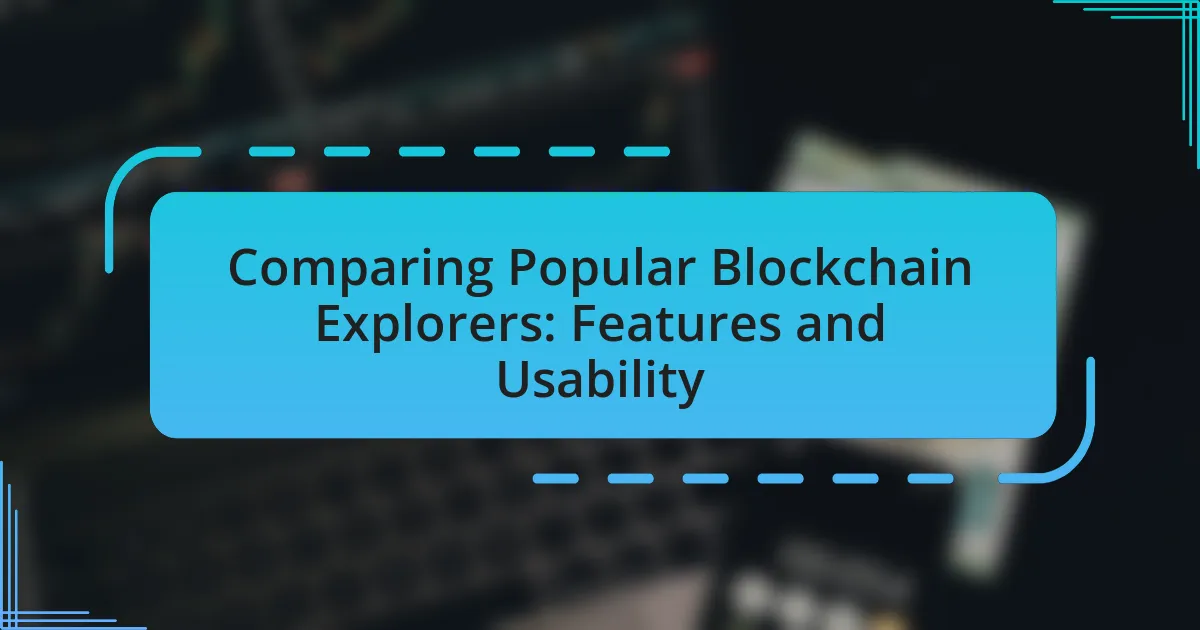The article examines the security implications of using blockchain explorers, which are tools that provide public access to blockchain transaction data. It highlights the risks associated with data leakage, privacy concerns, and potential phishing attacks, while also discussing how explorers enhance security through transparency and transaction verification. Key topics include the types of data displayed by explorers, the impact of transparency on security, and best practices for users to mitigate risks. The article emphasizes the importance of using reputable explorers and implementing secure browsing practices to protect user identities and financial information.
What are the Security Implications of Using Blockchain Explorers?
Using blockchain explorers can expose users to security risks such as data leakage and privacy concerns. Blockchain explorers provide public access to transaction data, which can be analyzed to trace the flow of funds and identify wallet addresses. This transparency can lead to potential threats, including targeted attacks on individuals or entities whose transaction patterns are revealed. Additionally, malicious actors may exploit the information gathered from explorers to conduct phishing attacks or social engineering schemes, as they can correlate on-chain data with off-chain identities.
How do blockchain explorers function in the context of security?
Blockchain explorers enhance security by providing transparent access to transaction data on the blockchain. They allow users to verify transactions, track the movement of assets, and audit the integrity of the blockchain. This transparency helps to prevent fraud, as all transactions are publicly recorded and immutable, making it difficult for malicious actors to alter transaction histories without detection. Additionally, blockchain explorers can identify suspicious activities, such as unusual transaction patterns, which can serve as an early warning system for potential security breaches. The ability to trace transactions back to their origin further strengthens the security framework of blockchain networks, as it promotes accountability and trust among users.
What data do blockchain explorers access and display?
Blockchain explorers access and display data related to transactions, blocks, and addresses on a blockchain network. They provide detailed information such as transaction IDs, timestamps, amounts transferred, sender and receiver addresses, block heights, and the status of transactions (confirmed or unconfirmed). For example, Bitcoin blockchain explorers show the total number of transactions in a block, the fees associated with each transaction, and the current balance of any public address. This data is crucial for users to verify transactions and monitor blockchain activity, enhancing transparency and security within the network.
How does the transparency of blockchain explorers impact security?
The transparency of blockchain explorers enhances security by allowing users to verify transactions and monitor network activity in real-time. This visibility helps identify suspicious behavior, such as double-spending or fraudulent transactions, thereby deterring malicious actors. For instance, the public nature of blockchain data means that any irregularities can be quickly spotted by the community, which acts as a form of decentralized oversight. Additionally, the ability to trace the flow of funds can assist in the recovery of stolen assets, further reinforcing the security framework of blockchain systems.
What are the potential risks associated with using blockchain explorers?
Using blockchain explorers poses several potential risks, primarily related to privacy and security. One significant risk is the exposure of transaction details, which can lead to the identification of users and their financial activities. For instance, blockchain explorers allow anyone to view transaction histories, which can be analyzed to trace the flow of funds and link them to specific individuals or entities. This transparency can compromise user anonymity, especially if users do not take additional privacy measures, such as using mixing services or privacy-focused cryptocurrencies.
Another risk involves the potential for phishing attacks. Malicious actors can create counterfeit blockchain explorer websites that mimic legitimate ones, tricking users into entering sensitive information or private keys. This can lead to unauthorized access to wallets and loss of funds. Additionally, reliance on third-party explorers can introduce vulnerabilities, as users may inadvertently trust inaccurate or manipulated data presented by these services.
Furthermore, the use of blockchain explorers can inadvertently expose users to regulatory scrutiny. As governments increasingly monitor blockchain transactions for compliance, users who frequently utilize explorers may attract unwanted attention, leading to potential legal implications. Overall, while blockchain explorers are valuable tools for transparency and analysis, they carry inherent risks that users must navigate carefully.
How can blockchain explorers expose user privacy?
Blockchain explorers can expose user privacy by allowing anyone to view transaction histories and wallet addresses associated with public blockchain networks. This transparency means that if a user’s wallet address is linked to their identity, their entire transaction history can be traced, revealing patterns of behavior and financial activities. For instance, studies have shown that blockchain analysis techniques can de-anonymize users by correlating transaction data with external information, such as IP addresses or social media profiles, thereby compromising user privacy.
What vulnerabilities can arise from relying on third-party explorers?
Relying on third-party explorers can lead to several vulnerabilities, including data manipulation, privacy risks, and dependency on external services. Data manipulation occurs when explorers alter or misrepresent transaction information, potentially misleading users about the state of the blockchain. Privacy risks arise because third-party explorers may track user activity and link transactions to identities, compromising anonymity. Additionally, dependency on external services can create single points of failure; if an explorer goes offline or is compromised, users may lose access to critical information or face security threats. These vulnerabilities highlight the importance of using trusted and secure explorers to mitigate risks associated with blockchain interactions.
What measures can be taken to mitigate security risks when using blockchain explorers?
To mitigate security risks when using blockchain explorers, users should employ secure browsing practices, such as using a virtual private network (VPN) and ensuring their devices have updated antivirus software. Secure browsing practices help protect user data from potential interception and malware attacks. Additionally, users should avoid entering sensitive information on blockchain explorers, as these platforms can be targeted by phishing attacks. According to a report by the Blockchain Security Alliance, over 60% of phishing attacks in the cryptocurrency space involve fake blockchain explorers, highlighting the importance of vigilance. Furthermore, users should verify the authenticity of the blockchain explorer by checking for HTTPS in the URL and looking for reputable sources or community recommendations. This verification process reduces the likelihood of accessing malicious sites that could compromise security.
How can users ensure they are using reputable blockchain explorers?
Users can ensure they are using reputable blockchain explorers by verifying the explorer’s credibility through established industry standards and user reviews. Reputable explorers typically have a long-standing presence in the blockchain community, often supported by positive feedback from users and endorsements from recognized cryptocurrency platforms. Additionally, users should check for secure connections (HTTPS) and look for transparency in the explorer’s operations, such as clear information about the team behind it and its data sources. For instance, explorers like Blockchair and Etherscan are widely recognized for their reliability and security features, making them trustworthy options for users.
What best practices should users follow to protect their data?
To protect their data, users should implement strong passwords, enable two-factor authentication, and regularly update their software. Strong passwords, which are at least 12 characters long and include a mix of letters, numbers, and symbols, significantly reduce the risk of unauthorized access. Two-factor authentication adds an extra layer of security by requiring a second form of verification, making it harder for attackers to gain access even if they have the password. Regular software updates ensure that users benefit from the latest security patches, reducing vulnerabilities that could be exploited by cybercriminals. According to a 2021 report by Verizon, 81% of data breaches are linked to weak or stolen passwords, highlighting the importance of these practices in safeguarding personal information.
How do blockchain explorers affect transaction security?
Blockchain explorers enhance transaction security by providing transparency and traceability of transactions on the blockchain. They allow users to verify transaction details, such as sender and receiver addresses, transaction amounts, and timestamps, which helps in identifying fraudulent activities or double-spending attempts. The public nature of blockchain data means that any suspicious transactions can be easily scrutinized by the community, thereby deterring malicious behavior. Additionally, the ability to track the flow of funds through various addresses can assist in law enforcement investigations, further reinforcing the security of the blockchain ecosystem.
What role do blockchain explorers play in transaction verification?
Blockchain explorers serve as essential tools for transaction verification by providing a transparent and accessible interface to view transaction details on a blockchain. They allow users to track the status of transactions, including confirmations, timestamps, and associated addresses, thereby ensuring the integrity and authenticity of the transaction data. For instance, in Bitcoin, explorers like Blockchair or Blockchain.com enable users to verify that a transaction has been included in a block and confirm its legitimacy through the blockchain’s immutable ledger. This verification process is crucial for maintaining trust in decentralized systems, as it allows users to independently validate transactions without relying on intermediaries.
How can explorers help identify fraudulent transactions?
Explorers can help identify fraudulent transactions by providing transparent access to blockchain data, allowing users to trace transaction histories and verify the legitimacy of activities. This transparency enables the detection of unusual patterns, such as multiple transactions from a single address or rapid transfers between accounts, which may indicate fraudulent behavior. Additionally, explorers often include features like transaction tagging and clustering analysis, which can further assist in identifying suspicious activities by grouping related transactions and highlighting anomalies.
What are the limitations of explorers in ensuring transaction security?
Explorers have significant limitations in ensuring transaction security, primarily due to their reliance on publicly available data and lack of control over the underlying blockchain. They can only display transaction information that has already been recorded on the blockchain, which means they cannot prevent fraudulent activities or unauthorized transactions. Additionally, explorers do not provide mechanisms for verifying the authenticity of transactions; they merely present data without context or validation. This lack of verification can lead to misinformation or misinterpretation of transaction statuses. Furthermore, explorers are vulnerable to attacks such as data manipulation or phishing, which can compromise user trust and security.
How can the use of blockchain explorers impact network security?
The use of blockchain explorers can enhance network security by providing transparency and facilitating real-time monitoring of transactions. By allowing users to view transaction histories and wallet balances, blockchain explorers help identify suspicious activities, such as double-spending or unauthorized transactions. This visibility can deter malicious actors, as their actions become traceable and publicly accessible. Furthermore, the ability to analyze transaction patterns can aid in detecting anomalies, thereby strengthening the overall security posture of the network.
What are the implications of public access to blockchain data?
Public access to blockchain data enhances transparency but raises significant privacy and security concerns. The open nature of blockchain allows anyone to view transaction histories, which can lead to the identification of individuals and their financial activities. For instance, a study by the Cambridge Centre for Alternative Finance highlights that public blockchain data can be analyzed to trace the flow of funds, potentially exposing users to targeted attacks or fraud. Additionally, the availability of this data can facilitate illicit activities, as malicious actors may exploit the information for money laundering or other criminal purposes. Thus, while public access promotes accountability, it simultaneously necessitates robust security measures to protect user privacy and prevent misuse.
How can explorers be used to analyze network activity for security threats?
Explorers can be used to analyze network activity for security threats by providing detailed insights into transaction patterns and user behaviors on blockchain networks. These tools allow security analysts to track and visualize transactions in real-time, identifying anomalies that may indicate fraudulent activities or security breaches. For instance, explorers can highlight unusual spikes in transaction volumes or connections to known malicious addresses, enabling proactive threat detection. The ability to trace the flow of funds and assess the legitimacy of transactions enhances the overall security posture of blockchain systems, as evidenced by the use of blockchain analytics in high-profile investigations, such as the tracking of illicit transactions in cryptocurrency exchanges.
What are the best practices for using blockchain explorers securely?
To use blockchain explorers securely, users should prioritize privacy, avoid sharing sensitive information, and utilize reputable explorers. Maintaining privacy involves not disclosing personal details or wallet addresses that could link to one’s identity. Users should also ensure they are accessing well-known and trusted blockchain explorers, as lesser-known sites may pose security risks or contain malware. Additionally, employing a Virtual Private Network (VPN) can enhance security by masking the user’s IP address, further protecting their identity while browsing. These practices help mitigate risks associated with data exposure and enhance overall security when using blockchain explorers.
How can users protect their identities while using blockchain explorers?
Users can protect their identities while using blockchain explorers by employing privacy-focused tools and practices. Utilizing a Virtual Private Network (VPN) masks the user’s IP address, making it harder to trace their online activity. Additionally, users should consider accessing blockchain explorers through anonymous browsers like Tor, which further enhances privacy by routing internet traffic through multiple servers.
Moreover, avoiding the use of personal information when creating accounts or interacting with blockchain services minimizes the risk of identity exposure. Users can also opt for privacy-centric cryptocurrencies that offer enhanced anonymity features, such as Monero or Zcash, when conducting transactions. These measures collectively help in safeguarding user identities against potential tracking and surveillance associated with blockchain explorers.
What tools can enhance privacy when accessing blockchain data?
Privacy-enhancing tools for accessing blockchain data include VPNs, Tor, and privacy-focused blockchain explorers. VPNs encrypt internet traffic, masking the user’s IP address, which helps maintain anonymity while accessing blockchain data. Tor further anonymizes user activity by routing connections through multiple servers, making it difficult to trace the source of the request. Privacy-focused blockchain explorers, such as Blockchair and Wasabi Wallet, allow users to view blockchain data without revealing their identity or transaction history. These tools collectively contribute to a more secure and private experience when interacting with blockchain networks.
How can users verify the authenticity of blockchain explorers?
Users can verify the authenticity of blockchain explorers by checking their source code and ensuring they are open-source. Open-source explorers allow users to review the code for security vulnerabilities and confirm that the explorer operates as claimed. Additionally, users should look for explorers that are widely recognized and recommended by the blockchain community, as reputable explorers often have a history of reliability and transparency. Users can also verify the explorer’s connection to the blockchain by comparing transaction data with multiple explorers to ensure consistency.
What common mistakes should users avoid when using blockchain explorers?
Users should avoid assuming that all blockchain explorers provide the same level of accuracy and security. Different explorers may have varying degrees of reliability, and some may even present misleading information. For instance, users often mistakenly trust data from unverified or lesser-known explorers, which can lead to incorrect transaction confirmations or misinterpretations of blockchain activity. Additionally, users should not overlook the importance of privacy; sharing wallet addresses or transaction details on public forums can expose them to risks such as phishing attacks. Lastly, users frequently neglect to verify the authenticity of the explorer’s website, which can result in falling victim to phishing sites that mimic legitimate explorers.
How can misunderstanding blockchain data lead to security issues?
Misunderstanding blockchain data can lead to security issues by causing incorrect interpretations of transaction histories and ownership, which may result in unauthorized access or fraudulent activities. For instance, if a user misreads the data regarding the status of a transaction, they might mistakenly believe that a transaction has been confirmed when it has not, leading to the potential for double-spending or loss of funds. Additionally, inaccurate understanding of wallet addresses and their associated balances can facilitate phishing attacks, where malicious actors exploit this confusion to redirect funds. Research indicates that user errors in interpreting blockchain data are a significant factor in security breaches, highlighting the importance of accurate data comprehension in maintaining the integrity of blockchain transactions.
What are the risks of sharing sensitive information on explorers?
Sharing sensitive information on explorers poses significant risks, including data exposure, privacy breaches, and potential financial loss. Explorers, which are tools for viewing blockchain transactions, can inadvertently reveal personal information if users share identifiable data. For instance, if a user links their wallet address to personal information, anyone can trace transactions back to them, compromising their anonymity. Additionally, malicious actors can exploit this information for phishing attacks or to target individuals for fraud. The transparency of blockchain technology means that once sensitive information is shared, it is permanently recorded and accessible, making it crucial for users to exercise caution when interacting with explorers.
What practical tips can enhance security when using blockchain explorers?
To enhance security when using blockchain explorers, users should prioritize using reputable and well-established explorers. Reputable explorers often implement security measures such as HTTPS encryption, which protects data during transmission. Additionally, users should avoid entering sensitive personal information or private keys into any blockchain explorer, as these platforms are primarily designed for public data access and may not be secure for sensitive transactions. Furthermore, utilizing a virtual private network (VPN) can add an extra layer of security by masking the user’s IP address and encrypting internet traffic. Regularly updating browser security settings and using ad-blockers can also help mitigate risks associated with malicious ads or phishing attempts.
How can users stay informed about the latest security threats related to explorers?
Users can stay informed about the latest security threats related to explorers by subscribing to cybersecurity news feeds and following reputable security blogs. These sources often provide timely updates on vulnerabilities and exploits affecting blockchain explorers. Additionally, users can join online forums and communities focused on blockchain security, where professionals share insights and experiences regarding emerging threats. Engaging with platforms like Twitter or LinkedIn can also help users follow industry experts who regularly post about security developments.
What resources are available for learning more about secure blockchain exploration?
Resources for learning about secure blockchain exploration include academic papers, online courses, and specialized websites. Notable academic papers such as “Blockchain Technology: Beyond Bitcoin” by M. Crosby et al. provide foundational knowledge on blockchain security. Online platforms like Coursera and edX offer courses on blockchain technology that cover security aspects. Additionally, websites like CoinDesk and Blockchain.com provide articles and guides focused on secure practices in blockchain exploration. These resources collectively enhance understanding of the security implications associated with using blockchain explorers.





